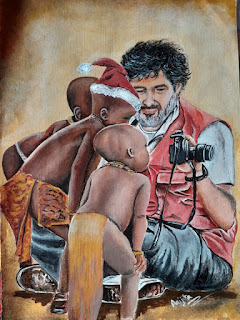SPOTLIGHT ON: ALOK JOHRI
Life's Still Yet Most Precious Moments
Artist Alok Johri (left) with the show curator Jaiveer Johal (centre) and Tunty Chauhan of Gallery Threshold
Some of my earliest memories of beautiful paintings —
that I found beautiful as a child — were still-lifes. Of course, I didn’t know
then that they were called ‘still-lifes’. Those were images of la vie quotidienne — images of everyday
life that inspire us to see beauty in every little, seemingly inconsequential thing
around us. Europeans, who popularised it, found that beauty most popularly in
things and objects on a dining table. It began as a distinct genre in its own
class in the Netherlands in the 16th-17th centuries, but
some of the most fabulous examples were created all over the European
continent, by artists such as Caravaggio, Jan Brueghel the Elder, Rembrandt,
Vermeer, to name a few. Closer to our times, Vincent van Gogh and Pablo Picasso
are other names whose still-lifes we are all very familiar with.
It wouldn’t be an overstatement to say that almost
every artist, at some point in their career, tries still-life. Modern Indian
masters have done that, with the most striking example, in my opinion, remains
those by F. N. Souza and Jyoti Bhatt, to quote only two examples.
The most striking thing about Johri’s still-lifes is
that they are redolent with emotion; so much so that one knows in an instant
that each of those still-lifes carries some story behind it. It is very
apparent that Johri’s canvases are not just an aesthetic depiction of what he
sees beautiful around him, which, however, remains a primary reason for him to
train his lens on any collection of objects; but there’s more to it.
The large diptych, …Over
Tea, that greets the viewer upon entering the gallery is striking as
evidently there is a story waiting to be told. There is something about the way
the ruffled edge of the tablecloth, an open book with a pair of spectacles on
it, a toppled cup and saucer… “It’s my way of remembering my father and my
mother. The work shows a 20th Century Chamber’s Dictionary, and
below that, the last book that my mother read,” says Goa-based Johri. The
artist, who grew up in Kanpur, studied applied arts at Lucknow University after
switching from fine arts whose entrance test he had topped, upon the advice of
his HoD, the renowned artist B. N. Arya. He went on to work in advertising,
achieving great success, before going solo to travel the country with his
camera.
It's hard to believe that he didn’t train as a painter because the works on display exude depth and gravity of skills honed over years. “I was good at the arts — doodling, drawing, painting — since childhood, and I remember that when I was 8-9 years old, my mother asked me what would I want to be when I grew up, I remember replying that I wanted to be an artist,” shares Johri.
One of a set of 4 works by Alok Johri, titled 'Inheritance'
Just as …Over
Tea captivates with its stark bareness and an overbearing sense of an
active snippet of life frozen in time, his other works, including the small
ones measuring 10 x 10 in., or 17 x 17 in., or 24 x 24 in., draw in the eye
with their zoomed in details of daily life. A
Short Nap, Man with his thoughts,
Mocha, Afternoon, Siesta… and
many more lay bare the most common of our moments on the earth with the
uncommon vision of a painter. A Short Nap,
for instance, focuses on a head turned the other way with the arm of the
subject wrapped around it so as to shield it from day light when someone tries
to take a quick nap in the middle of some work. Similarly, Every Morning shows the corner of a table covered with a tablecloth
and the back rest of a chair pulled out just a bit as if someone has just
gotten up and left the table. It’s a powerful snapshot of a morning which shows
the pithy observation of the painter.
There’s a lot of references to reading in the
paintings, which inadvertently alludes to the artist’s growing up years in an
academic household; both his parents were teachers. During a very enriching
conversation, the artist reveals that placing objects associated with his
parents in the paintings has also helped him reconcile with the difficult
relationship he had with his family. “My father left us in December 1987 as he
took sanyas. We never saw him again.
Years later, when my mother was shifting from Lucknow to Goa with me, I opened
an old trunk of academic books and found my father’s dictionary. My mother was
a voracious reader. So, books find a place in my works,” shares Johri.
While a few of Johri’s paintings took birth in the
recesses of memory in his mind, …Over Tea is the one that gave him closure over several conflicts he had
harboured in his head over the years with respect to his parents. “With this, I
resolved everything with my parents,” he shares at the end of a long, moving
story on his growing up years, which includes a vital landmark — the
disappearance of his father from their lives.
It is this profound experience that has, perhaps, helped Johri translate the minutiae of life on to his canvases, including those that are precious lived moments of all human life, and not just Johri’s, such as Dragon Fruit, Red Banana, Loofah, and Whisper, among others.
The exhibition, on view through October 12, is a
delight because Johri’s paintings start speaking of their stories, of the still
moments that they capture, which are not necessarily the artist’s, but resonate
with the common lives of all of us.











.jpg)


















.JPG)







